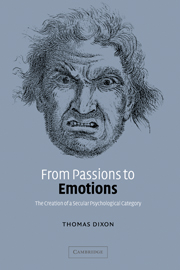Book contents
- Frontmatter
- Contents
- Acknowledgments
- Note on quotations
- 1 Introduction: from passions and affections to emotions
- 2 Passions and affections in Augustine and Aquinas
- 3 From movements to mechanisms: passions, sentiments and affections in the Age of Reason
- 4 The Scottish creation of ‘the emotions’: David Hume, Thomas Brown, Thomas Chalmers
- 5 The physicalist appropriation of Brownian emotions: Alexander Bain, Herbert Spencer, Charles Darwin
- 6 Christian and theistic responses to the new physicalist emotions paradigm
- 7 What was an emotion in 1884? William James and his critics
- 8 Conclusions: how history can help us think about ‘the emotions’
- Bibliography
- Index
7 - What was an emotion in 1884? William James and his critics
Published online by Cambridge University Press: 22 September 2009
- Frontmatter
- Contents
- Acknowledgments
- Note on quotations
- 1 Introduction: from passions and affections to emotions
- 2 Passions and affections in Augustine and Aquinas
- 3 From movements to mechanisms: passions, sentiments and affections in the Age of Reason
- 4 The Scottish creation of ‘the emotions’: David Hume, Thomas Brown, Thomas Chalmers
- 5 The physicalist appropriation of Brownian emotions: Alexander Bain, Herbert Spencer, Charles Darwin
- 6 Christian and theistic responses to the new physicalist emotions paradigm
- 7 What was an emotion in 1884? William James and his critics
- 8 Conclusions: how history can help us think about ‘the emotions’
- Bibliography
- Index
Summary
Undoubtedly the stimulating and highly valuable influence of James' treatment – here as on many other points – has been due to a certain frankness and naïve clearness which has concealed in a measure the real complexity of the problem.
James Mark Baldwin, ‘The origin of emotional expression’, 610William James' theory of emotion
It should now be clear that Charles Darwin and William James were not the authors of ‘the first studies of the emotions using scientific methodology’. Nor was James the first nineteenth-century thinker to adopt a passive ‘sensational’ or ‘feeling’ theory of emotion; Brown, Spencer and Bain had all done so before him; they had all described emotions as aggregates or effects, whose constituents or causes were sensations. It is no coincidence that William James had spent his youth ‘immersed in Dugald Stewart and Thomas Brown’; the latter's view of the emotions was at the root of James' own.The ‘feeling’ theory of emotion was, nonetheless, given its most widely remembered formulation by William James: emotions for James were passive mental feelings of movements of the viscera. The most striking thing about James' theory of emotions, and the reason for its lasting fame, was its clarity and simplicity. What was most novel about it was the priority given to the viscera rather than the brain (or indeed the soul) in causing emotional feelings.
- Type
- Chapter
- Information
- From Passions to EmotionsThe Creation of a Secular Psychological Category, pp. 204 - 230Publisher: Cambridge University PressPrint publication year: 2003



